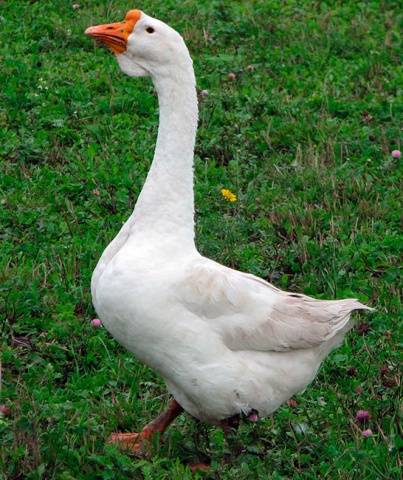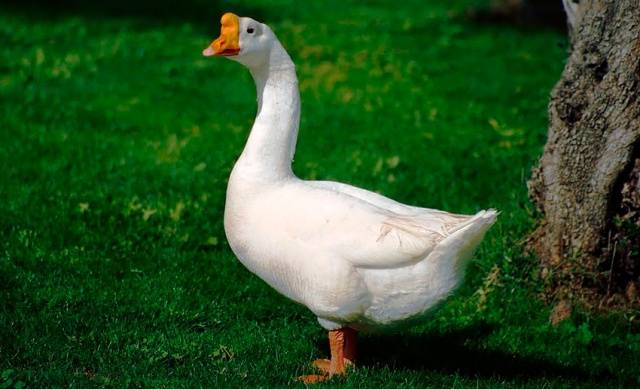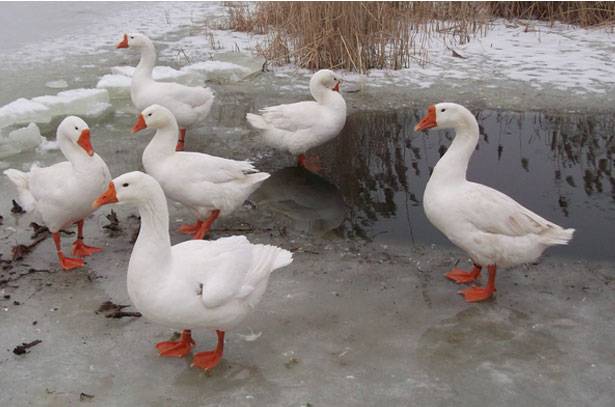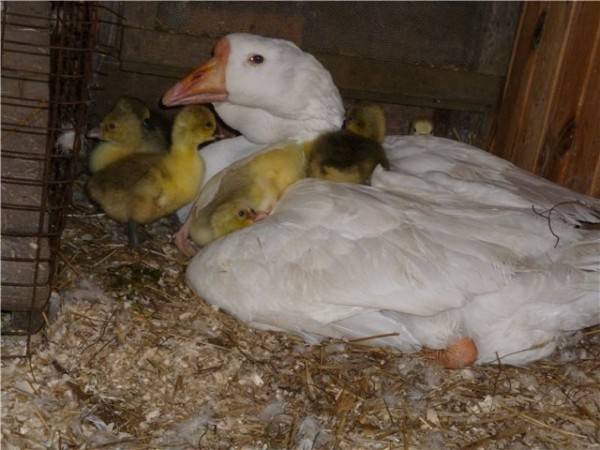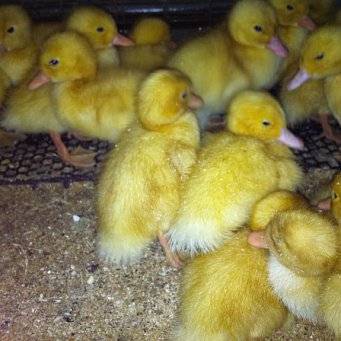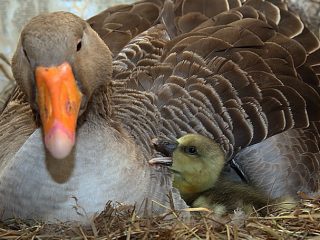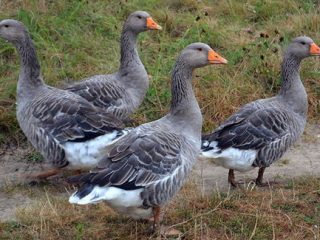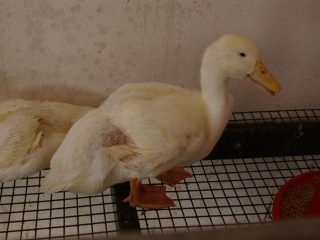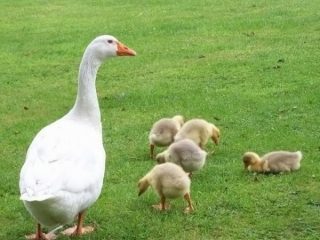Content
Even in Ancient Rus', geese were one of the most numerous birds in farmsteads. This was explained by the extreme profitability of the goose, which does not require feed in the summer. Geese are herbivorous birds. They don’t even feed on duckweed and plankton, like ducks, but on coastal grass.
Geese need a pond. But not as a source of food. The grass is thicker near bodies of water, making it easier to find food and hide from predators. Due to their body weight, it is difficult for geese to mate on land and they prefer water. With “dry” mating, the number of fertilized eggs decreases.
Russia has always been rich in reservoirs, so the geese had no problems. In the spring they raised goslings and grazed in the meadows all summer. And in the fall, the owner of the goose flock received free goose meat for the winter by slaughtering the grown young animals.
A goose can easily live even in those farms that do not have the opportunity to provide it with access to a pond, since bodies of water are vital for swans.
Although geese have been popular in Rus' since ancient times, so much so that they even found their way into fairy tales, geese of the Linda breed were bred quite recently, in 1994.
This breed was bred in the Nizhny Novgorod region, which is why geese of the Linda breed are sometimes also called Gorky. In terms of its productive characteristics, this breed turned out to be one of the best. Lindovsky geese were bred by crossing local stock with Chinese white geese.
Geese Linda, description of the breed with photos
Lindovsky geese are large representatives of their species. An adult gander can weigh up to 12 kg. True, in most cases due to a large amount of fat. The usual weight of a goose is about 8 kg, and that of a goose is 7 kg. Young animals at 3 months, by the end of the summer period, gain 4 kg. Considering that the egg production of geese is from 50 eggs per year, in the worst case scenario: 20% of hatched goslings, you can get a young bird with a total weight of 40 kg. At the same time, reference books claim that the fertilization rate of eggs from geese of the Lindov breed is 95%, and the hatchability rate is 70%. Thus, one goose will produce 280 kg of young animals. Of course, the slaughter yield of meat will be lower, but you can get about 180 kg of meat.
As a result, the owner will be faced with the question of where to put the products. To provide for a family, one or two geese are enough, but it is not customary to keep such a number and usually several families are kept at the rate of 3 geese per 1 gander.
Lindas are white geese with a characteristic transition from beak to skull. If usually in all birds this transition is smoothed out and forms an almost straight line, then in Lindov birds the transition is very sharp. One gets the impression that the beak is attached to the skull at a right angle, forming a bump typical of Lindovian geese.
In addition to the bump, the lind is also distinguished by a “chin” hanging under its beak.
The ancestors of the Linda breed, the Chinese white geese, also have cones similar to those of Linda geese. But they don’t have such a pronounced “chin.”
The photo shows a Chinese white goose.
Advantages of Lindovian geese and their disadvantages
The advantages of Linda include their good frost resistance and ability to withstand 40-degree frosts, which makes geese of this breed indispensable for breeding at home in the northern regions. A private owner does not always have the opportunity to provide warm wintering quarters for animals. In the northern regions, the main maintenance requirement is breeds of geese Linda – absence of drafts.
Geese of the Linda breed mature at 8 months, that is, the very next year they begin to lay eggs. Geese are good hens. And then they protect the chicks, so about 70% of the goslings survive.
In addition, Lindov geese have a calm disposition, easily getting along with their relatives.
The disadvantages include the inability to release goslings to pasture before they reach one and a half months and the tendency of the Lindov breed to hymenolepiasis and vitamin deficiencies. In addition, these geese require a body of water.
Content Features
Lindas need a poultry house with deep litter, feeders and nests. The size of the poultry house is based on 2 m² for 3 birds. If the population becomes too crowded, the geese stop laying eggs and the flock begins to get sick or lose feathers. Nests are made measuring 0.4x0.6x0.5 m. It is believed that a nest of this size is enough for 2 - 3 geese. If the egg is planned to be hatched, then yes. If you plan to hatch eggs naturally, then there should be one nest for each hen.
This is explained by the fact that:
- geese are likely to start laying eggs at different times;
- when two or more females collide in a nest, they compete for a place to lay eggs;
- during the struggle, the eggs are at best mixed, at worst they are broken through by claws;
Since eggs are laid at different times, when the first goose has already laid eggs, the last one is still laying eggs. As a result, eggs have different incubation periods. During the incubation process, the geese will mix the eggs among themselves several times. Some eggs will end up outside, cool down, the embryo will die, the geese will sit on these eggs again, leaving the next batch to cool. As a result, there will be no goslings at all.
Therefore, we must try to identify each goose by its own nest, although this does not always work. The birds are stubborn and may try to nest in the same place.
Incubation method of breeding geese
Eggs that were laid no later than 10 days before incubation are placed in the incubator. For the most part, geese lay eggs once every two days. In order for them to lay eggs every day, they need a diet of mixed feed for laying hens.
The question: how many geese are needed in the yard to completely fill the incubator is decided depending on the capacity of the machine and the goose diet.
Incubation regimes for other types of poultry differ from those for hatching goslings. Even duck eggs, which are most similar to goose eggs, are incubated 2 days less.
For this reason, goose eggs cannot be incubated with any other eggs and you must either fill the incubator to capacity, or it will not work at full capacity.
The temperature in the incubator in the first two weeks is kept at 37.8 ° C, maintaining humidity at least 60%.Turning the eggs must be done at least 4 times a day and it is better to let the incubator itself perform this function. True, most incubators turn the eggs every two hours. But taking into account the fact that the hens themselves can move the eggs up to 100 times a day, turning over every 2 hours is not terrible. Moreover, they are performed for the sole purpose: to prevent the embryo from becoming attached to the shell.
On the 28th day, the temperature is reduced to 37.5, and the humidity is increased to 85-90%. The humidity is increased in order to soften the egg shell and make it easier for the gosling to get out.
Perhaps the temperature regime was not maintained, the temperature was slightly lower than necessary and the goslings did not have time to fully develop. In this case, they hatch a day or two later.
If you force them out “on time,” it may turn out that the yolk sac has not yet been completely retracted into the abdominal cavity, and there is blood in the vessels on the wall of the egg. Such goslings will die.
Diet of Lindovian geese
Feeding lindas is not difficult, as they are practically omnivorous birds. It is better to feed goslings with starter broiler feed for up to 3 weeks, after which the goslings are transferred to regular broiler feed. With this feeding, goslings gain weight of 5 kg by 3 months.
Feeding goslings from one day of age
After a month and a half, when the goslings can be sent to pasture, the owner needs to decide what to feed the geese. Should I continue to give compound feed to gain weight as quickly as possible, or is it better to wait longer, but on free grass?
After the goslings gain an average body weight of 7 kg, their growth slows down significantly and further maintenance becomes unprofitable. If the bird was fattened for meat, it is slaughtered. If these are self-repairing young animals, they are transferred to cheap feed.
How to determine the sex of geese
When selecting young animals for self-repair or purchasing fresh blood for your livestock, it is important to know how to distinguish a goose from a goose, since until the geese grow to full size, it can be difficult to figure out where the gander is and where the goose is. In addition, the gander may also turn out to be small. Therefore, a more reliable way would be to determine the sex of the goose by checking the cloaca. The video clearly shows how a gander differs from a goose.
A new way to determine the sex of geese
Such crosses produce a lot of meat, but reproductive functions must be checked.
Reviews from owners of Lindovian geese
Conclusion
The newly bred breed of Lindov geese meets modern poultry farming requirements: maximum weight in minimum time. When kept in private household plots, Linda geese can produce a significant amount of tasty meat for the winter.


